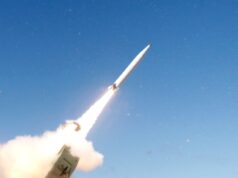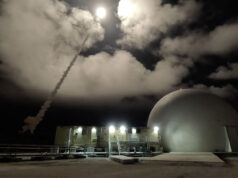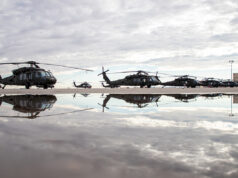Sikorsky and Boeing today released details of its advanced helicopter, named DEFIANT X, for the U.S. Army’s Future Long Range Assault Aircraft competition, known as FLRAA.
The aircraft, according to its builders, will be “the fastest, most manoeuvrable and most survivable assault helicopter in history”.
“DEFIANT X is a complete weapon system that builds on the handling qualities and transformational capabilities proven by the team’s technology demonstrator, SB>1 DEFIANT. With unmatched range and survivability, DEFIANT X will to fly low and fast through complex terrain, land quickly, deliver soldiers and equipment to the objective area (referred to as “the X”) and get out. DEFIANT X flies twice as far and fast as the venerable Black Hawk helicopter it is designed to replace. Currently undergoing testing in a digital combat environment, the aircraft continues to prove itself the most survivable platform for mission requirements.
With its rigid coaxial rotor system and pusher propeller, DEFIANT X incorporates Sikorsky X2 Technology™ to operate at high speeds while maintaining low-speed handling qualities. This critical capability provides soldiers with increased maneuverability and survivability in high-threat air defense environments, allowing them to penetrate enemy defenses while reducing exposure to enemy fire.”
You can view the photos and video on the DEFIANT X website http://www.boeing.com/defiantx.
“We are ready to deliver unparalleled capabilities backed by proven technologies that will truly transform the Army’s mission today – with room to grow and adapt to the missions of tomorrow,” said Andy Adams, Sikorsky vice president of Future Vertical Lift.
“DEFIANT X not only includes the transformational aircraft, mission systems and revolutionary sustainment solution, but also leverages Sikorsky’s and Boeing’s advanced manufacturing capabilities.”
The U.S. Army is expected to release a request for proposal on FLRAA later this year, with a contract award expected in 2022.










Revolutionary design…..let’s hope it is more successful than its Bolton-Paul namesake!
Defiant was meant to b a Bomber Destroyer , no one envisaged ” Ze Germans” flying from as close France , so Defiant really gets a bad rap .
I can’t think of any other single-engined aircraft with a turret except the TBM3 Avenger. But that was a monster with a torpedo armament and I’m not sure if the turret was terribly effective!
Having read the reports the Defiant performed rather well for the time until they added the turret. It’s methodology wasn’t totally flawed really as the Germans used similar logic flying below and firing up a few years later but in a more by then effective manner with radar at the core that took terrible tolls of British bombers At night. By then the defiant was too small and too slow to accomplish much success of that concept equally well and bigger and better night fighters making better use of radar could do a far better job in a more conventional manner and German bombers were far less well armed against conventional attack patterns. But if France hadn’t fallen their time may well have come if in a rather niche way I suspect.
Yes, I remember from my youth the air fix kits of the Messerschmitt 210 and the Heinkel owl. Twin engined 400 mph aircraft with UHF radar and heavy cannons firing upwards at about 45 degrees from the horizontal. Lethal machines and much better night fighters than the Allies had. The Germans really had some amazing aircraft in the second half of WW2.
I disagree, the Mosquito night fighter variants were incredibly effective. The ‘Intruders’ terrorised the Luftwaffe night fighter force by hunting them down over the continent and patrolling known night fighter airfields. Mosquito NF variants claimed over 600 kills during the war.
Eric Brown put the HE219 myth to rest openly stating having flown both it and the Mosquito the 219 was more a mosquito appetizer than destroyer , and as far as radar again the Germans had nothing in the Centemtric scale which meant Mozzies could feast on Heinkel 219’s and Junkers 88’s and 110,s at lower altitudes where they were effectively blind . Also at higher altitudes it being over 80 Mph fast than the 219 could feast there as well .
I can think of a couple more: SU-2 was one, interesting Russian aircraft, plus the Blackburn Roc which was similar to the Defiant if you are interested. The Roc was a Fleet Air Arm fighter and had a short service as a frontline aircraft.
Not so revolutionnary.
https://en.wikipedia.org/wiki/File:Lockheed_AH-56_Cheyenne.jpg
But clearly interesting if really less costly to operate than a tiltrotor like the V22.
I can see a major issue with this aircraft, its height. Although potentially useful for the US Army and US Air Force the Marines and Navy will have an issue getting these into hangers.
Is that less than 4 meters? If not it cant fit in a C-17 either
Probably mostly dictated by the blade wash and flex envelope to keep the counter rotating rotors sufficiently separated?
You could conceivably have the ‘neck’ separation of the blades hydraulically reduced for stowage. Although I shudder to think of the cost and maintenance implications of that.
Correct, in some respects you have to think of a coaxial design as a biplane. The two sets of blades although do not intermesh, the act of them spinning creates spiralling vortices from the blade tips. These converge and mix, the closer together the stronger the vortice along with drag. The interaction of the airflow between the upper and lower blade creates a shearing moment and causes the airflow to tumble, which can disturb the amount of lift generated by the lower blade set. Furthermore, the height of the lower set of blades is related to the placement and diameter of the pusher propeller. If the blades are set too low, the tip vortices will interfere too much with the propeller. This is equally true if the propeller’s diameter is too large.
Overall the design is a compromise. It is a development of Sikorsky’s advanced blade concept. There is only so much you can gain from a powered main rotor, in terms of forward speed, range and achievable altitude. For hovering performance, a coaxial design cannot be beaten. The coaxial design means that the positive roll moment on the advancing blade side is balanced out by the opposing blade set. It also means there is next to no fuselage torque reaction to deal with. However, because the blades have a high aspect ratio, the parasitic drag is quite high. Furthermore, because of the length of the blade, the tips can suffer compressibility problems, as the local airspeed enters the transonic zone.
The Defiant prototype has only recently past 205 knots (235mph), whilst last December, the Valor hit 305 knots (350mph). With the crew stating there was plenty left in the pot.The problem for the Defiant is that it needs the main rotors powered, to develop lift. If it had a wing, the main rotor speed could be reduced, as the wing would produce more lift as it goes faster. The reduced rotor rpm will slow down the blade tips, thus slowing down the transition into compressibility.
A telescoping main rotor shaft is an interesting concept, though I’m not sure it would be strong enough to handle the aircraft’s weight transferred through the swash plate.
A V22 Osprey comes in at 5.51m high when folded so whilst much higher than a Blackhawk should still fit any carrier hangers. C17 obvious issue.
However, if you look at a Blackhawk the Defiant X is the same length, almost and by design. This means, using the picture on the helos web site (in the hanger) makes the X between 5.5 and 5.8m high before any attempt to reduce this height is made.
OK, highly inaccurate and really just a fun obs.
The V280 Valor is a lot lower in height fuselage wise than the V22 Osprey, although the V-tail does stick up some. Bell have shown a number of models of the Valor to the USMC. The hope is that they would replace their Hueys with the Valor. I have seen a large scale mock up somewhere. But the navalised version has a 90 degree twisting main wing, folding rotors and an inverted V-tail. It doesn’t look an awful lot taller than the Blackhawk in this configuration, so could be C17 capable.
But is it as good as this:
https://www.youtube.com/watch?v=ZC0LR3zAAjA
Nothing is as good as airwolf.
It’s funny looking back on the show and now being a little bit wiser, spotting all the errors – duh! There’s truth in the saying: “never meet your heroes”!
I always preferred blue thunder.
Looking more like the Fairy Rotodyne every time I see it?